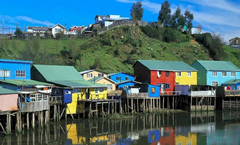Chiloe Island Chile, Nothern Patagonia
To cross to and
from the Island you need to take
a ferry.
The trip from mainland Chile to the Island takes about
30 minutes.
The Isla Grande of Chiloé is South America's largest island and among its most striking cultural anomalies. Divided by the gentle peaks of the Coastal Range, Chiloé's eastern and western coasts are two worlds apart. To the west is a wilderness of endless beaches, dune habitat, and temperate rainforests, much of it protected in one of Chile's most forgotten national parks. To the east are the scattered islands of the Chiloé archipelago, sheltered from Pacific storms, intensely cultivated, home to a traditional culture of subsistence farmers, fishermen, and craftsmen.
To the east are the scattered islands of the Chiloé archipelago, sheltered from Pacific storms, intensely cultivated, home to a traditional culture of subsistence farmers, fishermen, and craftsmen.
Charles Darwin arrived in Chiloe on 28 June 1834 and was based there for six months, writing about his impressions of southern Chile in his diaries.
 "There is also something very attractive in the
"There is also something very attractive in the
simplicity and humble politeness -"
( February 4, 1835) Charles Darwin speaking of Chiloe's customs which are still alive today.
The Jesuit order made this corner of the earth their special responsibility, erecting schools and over two hundred elegant wooden churches, nine of which are protected as national monuments. A rich mythology - populated by strange trolls, sea monsters, and eerie ghost ships - is yet another mark of Chiloé's singular history.
 Unesco Criterion (iii): The mestizo culture resulting from Jesuit missionary activities in the 17th and 18th centuries has survived intact in the Chiloé archipelago, and achieves its highest expression in the outstanding wooden churches.
Unesco Criterion (iii): The mestizo culture resulting from Jesuit missionary activities in the 17th and 18th centuries has survived intact in the Chiloé archipelago, and achieves its highest expression in the outstanding wooden churches.
Today, Chiloé balances wild, unbridled nature with one of South America's most remarkable traditional cultures. Renowned for its seafood, its woolen handicrafts, and the warmth of its people, Chiloé is still a largely unknown destination for walking and biking, fishing, paddling and birding.
The town of Castro, characterized by its fleets of yellow fishing boats and distinctive palafito houses built on stilts above the tides, is easily accessible and provides a full range of tourist services. The charming islands of the archipelago, meanwhile, can only be visited by boat or kayak.
(excerpt from "Tourism Promotion Corporation of Chile")








 To the east are the scattered islands of the Chiloé archipelago, sheltered from Pacific storms, intensely cultivated, home to a traditional culture of subsistence farmers, fishermen, and craftsmen.
To the east are the scattered islands of the Chiloé archipelago, sheltered from Pacific storms, intensely cultivated, home to a traditional culture of subsistence farmers, fishermen, and craftsmen.  "There is also something very attractive in the
"There is also something very attractive in the  Unesco Criterion (iii): The mestizo culture resulting from Jesuit missionary activities in the 17th and 18th centuries has survived intact in the Chiloé archipelago, and achieves its highest expression in the outstanding wooden churches.
Unesco Criterion (iii): The mestizo culture resulting from Jesuit missionary activities in the 17th and 18th centuries has survived intact in the Chiloé archipelago, and achieves its highest expression in the outstanding wooden churches. Visit Santiago, Vina del Mar, Valparaiso then south to Puerto Montt / Puerto Varas, frutillar, Chiloe and a final view of the Puyehue Hot Springs before returning to Santiago
Visit Santiago, Vina del Mar, Valparaiso then south to Puerto Montt / Puerto Varas, frutillar, Chiloe and a final view of the Puyehue Hot Springs before returning to Santiago












 Webmasters:
Tasman Web Developers,
Webmasters:
Tasman Web Developers,  Hosting: Dreamhost
Hosting: Dreamhost